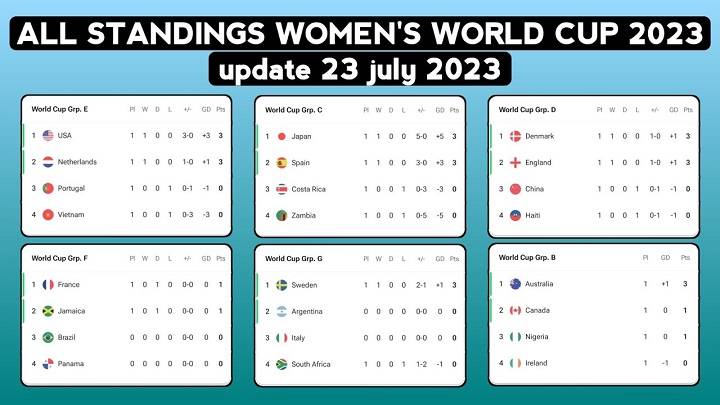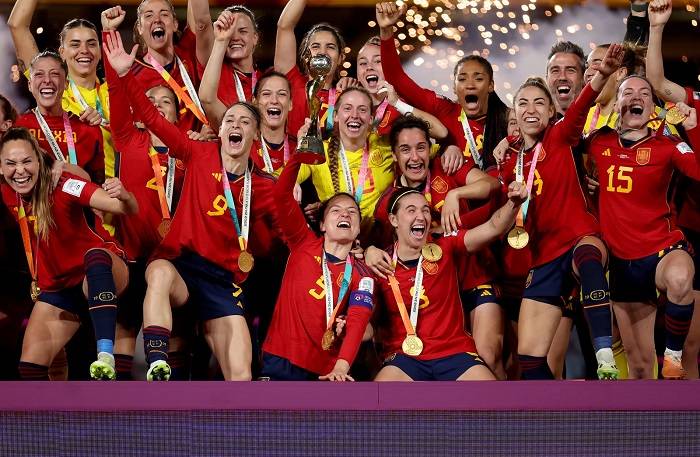The Women’s World Cup is one of the most prestigious events in international sports, showcasing the best female soccer players from around the globe. The competition is fierce, and the standings are a crucial part of the tournament, determining which teams advance and which teams face elimination. This blog post provides an in-depth look at the Women’s World Cup standings, exploring the history, structure, and significance of these rankings.
Introduction to the Women’s World Cup
History and Evolution
The Women’s World Cup, organized by FIFA, began in 1991, marking a significant milestone in the promotion of women’s soccer. The inaugural tournament was held in China and saw the United States emerge as the first champions. Since then, the tournament has grown in size and popularity, reflecting the increasing interest and investment in women’s sports globally.
Tournament Structure
The Women’s World Cup follows a format similar to the men’s version, with a group stage followed by knockout rounds. The number of teams has expanded over the years, from 12 in the first tournament to 24 in recent editions, with plans to further increase participation in future tournaments.
Understanding the Standings
Group Stage Standings
In the group stage, teams are divided into groups of four. Each team plays the others in their group once, and standings are determined by points:
- Win: 3 points
- Draw: 1 point
- Loss: 0 points
The top two teams from each group, along with the best-performing third-placed teams, advance to the knockout rounds. The criteria for ranking within the groups are as follows:
- Points obtained in all group matches
- Goal difference in all group matches
- Number of goals scored in all group matches
- Head-to-head results
- Fair play points
- Drawing of lots by the FIFA Organizing Committee
Knockout Rounds
The knockout rounds include the Round of 16, quarter-finals, semi-finals, and the final. Matches in these stages are single-elimination, with the winner advancing to the next round. In case of a draw, extra time and penalty shootouts are used to determine the winner.
Historical Standings and Trends
Dominant Teams
Over the years, certain teams have established themselves as dominant forces in the Women’s World Cup. The United States, Germany, and Norway have consistently performed well, often reaching the latter stages of the tournament and winning multiple titles.
Emerging Nations
In recent tournaments, there has been a noticeable rise in the performance of teams from countries where women’s soccer is rapidly developing. Nations like England, France, and Australia have shown significant improvement, challenging traditional powerhouses and adding excitement to the competition.
Underdog Stories
The Women’s World Cup has also seen its share of underdog stories. Teams with lower FIFA rankings have occasionally made deep runs in the tournament, capturing the hearts of fans and proving that anything can happen in soccer.
Key Factors Influencing Standings
Team Preparation and Investment
The level of preparation and investment in women’s soccer programs varies significantly across countries. Nations with well-funded programs and professional leagues tend to perform better in the World Cup, as they can provide their players with the resources and opportunities needed to compete at the highest level.
Coaching and Tactics
Coaching plays a crucial role in determining a team’s success. Skilled coaches can make a significant difference by implementing effective tactics, managing player rotations, and making strategic decisions during matches.
Player Performances
Individual player performances are often the deciding factor in critical matches. World-class players can turn the tide of a game with moments of brilliance, and having a deep roster of talented players is essential for maintaining consistency throughout the tournament.
Detailed Analysis of Recent Standings
2019 Women’s World Cup
Group Stage Highlights
The 2019 Women’s World Cup, held in France, featured 24 teams divided into six groups. The United States topped Group F with a perfect record, scoring 18 goals and conceding none. Other group winners included Germany, Italy, and France, each demonstrating their strength and depth.
Knockout Round Drama
The knockout rounds provided thrilling matches, with the United States defeating Spain, France, England, and the Netherlands to secure their fourth World Cup title. Standout performances came from players like Megan Rapinoe, who won the Golden Boot and Golden Ball awards.
Current Standings and Predictions
As the Women’s World Cup continues to evolve, the standings reflect ongoing shifts in the global soccer landscape. Emerging teams are challenging established powerhouses, and the competition is becoming more unpredictable and exciting. Analyzing current FIFA rankings and recent performances can provide insights into potential contenders for future tournaments.
Significance of Standings Beyond the Tournament
Impact on FIFA Rankings
World Cup standings significantly influence FIFA rankings, which are used to seed teams for future tournaments and qualifiers. Strong performances in the World Cup can boost a team’s ranking, leading to more favorable matchups in subsequent competitions.
Development of Women’s Soccer
Success in the World Cup can have a profound impact on the development of women’s soccer within a country. High-performing teams often receive increased attention and investment, leading to improved infrastructure, youth programs, and professional opportunities for female players.
Cultural and Social Impacts
The Women’s World Cup serves as a powerful platform for promoting gender equality and empowering women. High-profile performances and media coverage can inspire young girls to pursue sports and challenge societal norms, contributing to broader cultural and social changes.
Challenges and Controversies
Disparities in Investment
One of the major challenges facing women’s soccer is the disparity in investment compared to the men’s game. Despite recent progress, many countries still lack adequate funding for women’s soccer programs, affecting their ability to compete at the highest level.
Media Coverage and Public Perception
Media coverage of the Women’s World Cup has improved, but disparities remain. Increased visibility and coverage are essential for growing the sport and ensuring that women’s achievements receive the recognition they deserve.
Equal Pay and Professional Opportunities
The issue of equal pay and professional opportunities remains a contentious topic. Players and advocates continue to push for equitable treatment and compensation, highlighting the need for systemic changes within soccer organizations and governing bodies.
Future of the Women’s World Cup

Expansion and Inclusivity
FIFA has announced plans to expand the Women’s World Cup to include more teams, reflecting the growing interest and participation in women’s soccer globally. This expansion aims to provide more opportunities for countries to compete and develop their soccer programs.
Technological Advancements
Advancements in technology, such as VAR (Video Assistant Referee) and improved broadcasting capabilities, are enhancing the viewing experience and ensuring fair play. These innovations are likely to continue shaping the future of the Women’s World Cup.
Grassroots Development
Investing in grassroots development is crucial for the long-term success of women’s soccer. Programs that focus on youth development, coaching education, and community engagement are essential for building a strong foundation for future generations of players.
Standout Players and Their Impact on Standings
Legends of the Game
Players like Mia Hamm, Birgit Prinz, and Marta have left an indelible mark on the Women’s World Cup. Their performances have not only influenced their teams’ standings but have also inspired countless young players around the world.
Current Stars
Today’s stars, such as Alex Morgan, Sam Kerr, and Vivianne Miedema, continue to elevate the game with their skill and determination. Their contributions are pivotal in their teams’ success and have a significant impact on the standings.
Rising Talents
The emergence of young talents, such as Canada’s Jordyn Huitema and England’s Lauren James, highlights the bright future of women’s soccer. These players are poised to make significant contributions in future World Cups, potentially altering the competitive landscape.
Related Post:
How Many Weeks in a Year? Understanding the Calendar and Its Implications
Timberwolves vs. Denver Nuggets: Analyzing Player Stats in Their Latest Matchup
What Dinosaur Has 500 Teeth? A Comprehensive Look at Nigersaurus
The Women’s World Cup is more than just a tournament; it is a celebration of talent, determination, and progress. The standings reflect the competitive nature of the event and the dedication of the players and teams involved. As we look forward to future tournaments, it is essential to recognize the broader impact of the Women’s World Cup on the development of soccer and its role in promoting gender equality and empowering women worldwide.
By understanding the intricacies of the standings and the factors that influence them, fans and stakeholders can better appreciate the efforts and achievements of the teams and players. The Women’s World Cup will continue to inspire and captivate audiences, fostering a greater appreciation for women’s sports and the incredible athletes who compete at the highest level.




